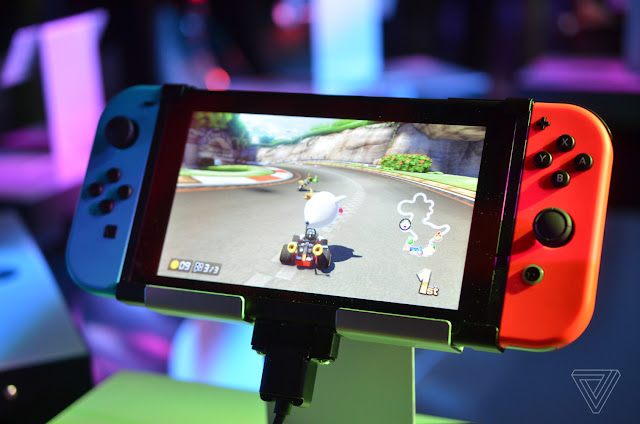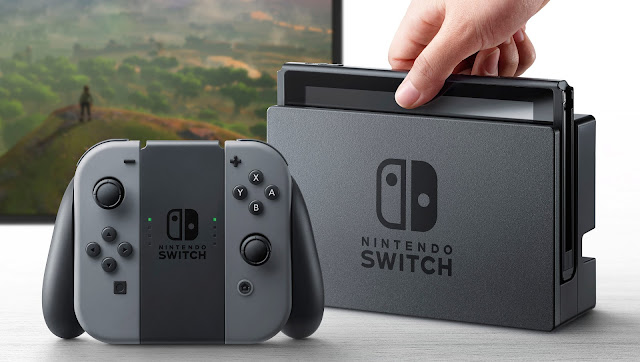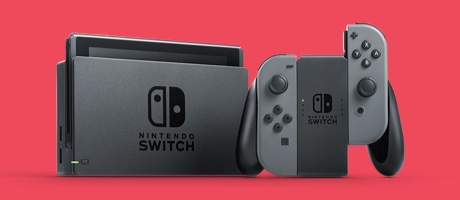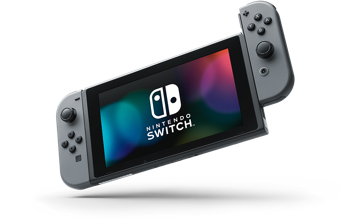Nintendo Switch 2017 Full Review |Technology inside World
Nintendo Switch – What is it?
You can manage Nintendo eShop purchases via your Nintendo Account. You may also limit sharing on social networks, restrict access to games based on their ESRB ratings, and more. A free app gives you even more choices and a handy way to manage your Nintendo Switch parental controls from anywhere via your mobile device.
 Play online with other Nintendo Switch gamers.
Play online with other Nintendo Switch gamers.
One controller or two, vertical or sideways, motion controls or buttons…Joy‑Con and Nintendo Switch give you total gameplay flexibility.
The Nintendo Switch is the seventh major video game console developed by Nintendo. Known in development by its codename NX, it was unveiled in October 2016 and was released worldwide on March 3, 2017.Nintendo does things differently. First came the Wii’s motion controllers, then Wii U’s tablet-style GamePad. Now the Nintendo Switch delivers a portable and home console in one that works well wherever you want to play on the go as well as at home.With a 6.2-inch tablet and two versatile, removable Joy-Con controllers, capable of used solo or split for local two-player multiplayer. While lacking the raw power to produce 4K HDR graphics like its rivals, its innovative design is a surprising hit.


Designed to bring games to life
Parental controls
Keep the focus on fun by using parental controls to manage how your family interacts with Nintendo Switch.
 |
You can manage Nintendo eShop purchases via your Nintendo Account. You may also limit sharing on social networks, restrict access to games based on their ESRB ratings, and more. A free app gives you even more choices and a handy way to manage your Nintendo Switch parental controls from anywhere via your mobile device.
Get the gaming system that lets you play the games you want, wherever you are, however you like.
This bundle includes the Nintendo Switch console and Nintendo Switch dock in black, and left and right Joy‑Con controllers in a contrasting gray. It also includes all the extras you need to get started.
This bundle includes the Nintendo Switch console and Nintendo Switch dock in black, and left and right Joy‑Con controllers in a contrasting gray. It also includes all the extras you need to get started.
Nintendo Switch – Design
As a result of the Switch’s dual purpose, it comes with quite a bit of gear.
Aside from the Switch and Joy-Con L and R, you get the Switch Dock for connecting the console to a TV. There’s also a Joy-Con Grip, which slots the left and right Joy-Con into it to act as a more traditional controller.
Then there are two Joy-Con straps for games that use motion controls, destined to be a blessing for ‘enthusiastic’ gamers – we don’t want another Wii fiasco with players smashing tellies. Finally, you get an HDMI cable and power lead.
It’s surprising quite how small Nintendo’s new flagship machine is. Strip away the dock and the Joy-Con controllers and what you have is a black box no bigger than a mini Android tablet.
The Nintendo Switch has a thick bezel around its 6.2-inch capacitive touchscreen. The display size is fine when playing games in portable mode, like a slightly larger PlayStation Vita screen, or perhaps a decent phablet. When in tabletop mode using the kickstand, it’s comfortable, but I had to sit closer to play Mario Kart 8 Deluxe in two-player local multiplayer because of the game’s frantic nature.The touchscreen’s responsiveness is streets ahead of the Wii U GamePad’s cheap and soft resistive screen, which often had delayed inputs and was a pain to use. This feels like I’m actually using a tablet.
In the hands the console feels incredibly well made, again a far cry from the GamePad’s Tonka Toy plastic. The metal finish of the Switch coupled with the comfortable (if a little weightless) Joy-Con make this the best console Nintendo has made from an aesthetic perspective, perhaps by any console manufacturer.
Compete against friends (or team up) at home.
 Play online with other Nintendo Switch gamers.
Play online with other Nintendo Switch gamers. |
| Link up to eight systems together to play anywhere. |
Nintendo Switch Battery Testing
With the Nintendo Switch pitched as a home console you can take on the go, its battery life is a key factor.
I wanted to test the battery and see how close the Switch got to Nintendo’s claims of 3-6 hours, depending on the game as well as the brightness and Wi-Fi settings.
I tested the Switch at two settings. For both tests I played Legend of Zelda: Breath of the Wild for one continuous hour, after which I charged the console using the supplied power adapter for another hour to see how much charge it recovered.
For test one, Zelda was played at 100% brightness, with Wi-Fi enabled. Test two was played at 50% brightness in Airplane mode. Here are the results:
100% Brightness and Wi-Fi enabled
-36% after one hour of play
+47% after one hour of charge
-36% after one hour of play
+47% after one hour of charge
50% Brightness and Airplane mode
-31% after one hour of play
+45% after one hour of charge
-31% after one hour of play
+45% after one hour of charge
The good news here is that the results are more or less exactly as Nintendo claims. Zelda is a good benchmark, given how demanding it is.
When used at 100% brightness with Wi-Fi enabled, I estimate you’d get around two hours and 45 minutes. That’s less than the three hours claimed by Nintendo, but not by much. All sorts of variables, such as the intensity of the section of the game you’re playing, could impact that result.
The second test, which is more typical of how most people will use the console on the go, is encouraging. At 50% brightness and in Airplane mode, you’d get around three hours and 15 minutes – a decent 30 minutes or so extra, and over Nintendo’s three-hour guideline.
I’m incredibly impressed that this dinky little machine can power three hours of gaming with high-end experiences like Breath of the Wild. And if you were to play simpler games that don’t push the hardware as hard, I’m sure you could get far more from the Switch.
It’s why I feel like Nintendo has missed a trick by not pitching this machine as the most powerful handheld console ever. It’s really underselling the machine’s portable prowess.
 |
This is Joy‑Con™ |
One controller or two, vertical or sideways, motion controls or buttons…Joy‑Con and Nintendo Switch give you total gameplay flexibility.
HD rumble makes games more immersive.
The Joy-Con Controller
Ahead of launch, myself and many players reported issues with the left Joy-Con. Nintendo has acknowledged the problem and provided a fix. It’s now offering to fix the Joy-Con free of charge – and not only that, but a change in the manufacturing process means that all future Switch consoles should no longer have the issue.
All that tech – HD Rumble, infrared and all the gyroscopic smarts of Wii MotionPlus – housed in two tiny little controllers feels a bit like overkill. Having played games that take advantage of this stuff, I now appreciate the Joy-Con’s versatility, but I still have concerns that much of it will be ignored beyond the launch games.
HD Rumble is a bit like virtual reality – you can’t really understand it without trying it. It wasn’t until I played the ball-counting game in 1-2-Switch that I realised how well it translates in the hand. It does genuinely feel like there are tiny balls moving up and down inside the Joy-Con. The gentle ‘bump, bump, bump’ of each ‘ball’ hitting the end of the Joy-Con is quite amazing, its accuracy a pleasant surprise.
HD Rumble also needs the Joy-Con to be held in your hand to work best. If using the Joy-Con grip, its hollow plastic design means the rumble dissipates and its intricacy isn’t appreciated. 1-2-Switch tells players to remove the Joy-Con from any accessory before playing certain games to ensure its effectiveness.
1-2-Switch also utilises the rest of the tech, with minigames using the IR sensor for players to eat a sandwich, the gyroscope for the likes of cowboy quickdraw, plate spinning, air guitar and even modelling on a catwalk. However, the problem is 1-2-Switch is pretty much the only game to take full advantage of what the controllers can do.








No comments